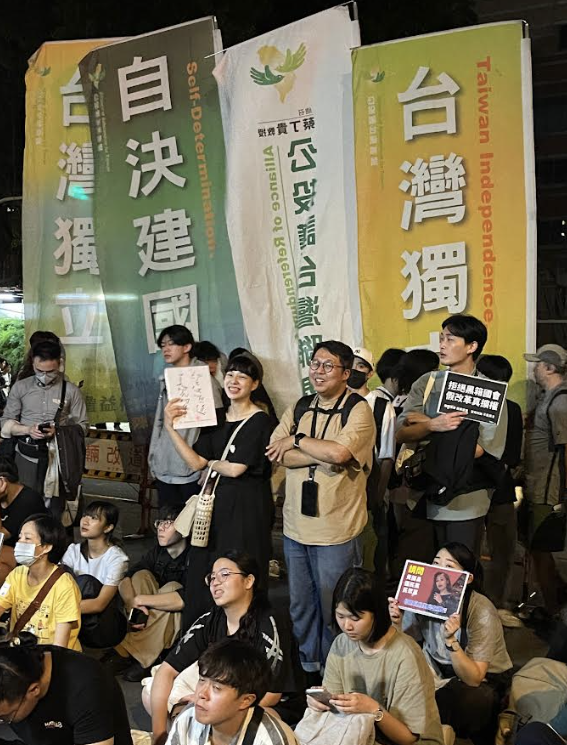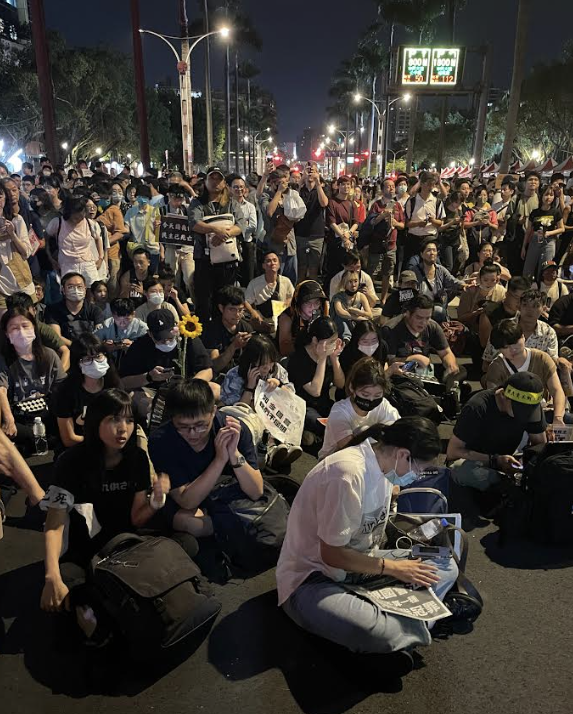
ADVANCING THE NEW WAVE OF THE PEOPLE POWER IN TAIWAN: JUSTIFYING THE BLUEBIRD ACTION
Written by Alan H. Yang.
Image credit: author. Pic 1. Activists gathering near the LY in the afternoon.
What happened?
In May 2024, crowds began to gather on Qingdao East Road(青島東路) near Taiwan’s Parliament (the Legislative Yuan, 立法院, hereafter LY) in Taipei, once reaching up to 100,000 people, to express peaceful protest against the controversy over the newly amended act (國會擴權法案) of LY promoted by the Kuomintang (KMT, 國民黨) and the People’s Party (TPP, 台灣民眾黨). The 21st and 24th of May were the days when the most activists gathered. At first, some people called it the Sunflower Movement 2.0 (太陽花運動2.0). There were three common features. First, similar to the Sunflower Movement, both movements were about safeguarding sovereignty and democratic values through self-mobilised movements led by students as well as leading activist groups in Taiwan. Second, the majority of participants in both movements are young people, even including some elementary students.
Third, the role of technology is critically important. Activist groups utilise digital technologies to communicate with and mobilise the participants in the rally. These digital technologies, nevertheless, also cause some concerns. Some activists found that if the content of their online posts included hashtags such as “Qingdao”(青島) or “Qingdao East”(青島東), referencing the location of the Legislative Yuan and the protests, the social media algorithm appeared to reduce the potential online audience. Therefore, citizens strategically adopted “Qingniao”(青鳥), a term that shares similar characters with “Qingdao” but translates to “bluebird,” as a replacement to tackle the social media algorithm. Then it was later renamed formally as “Bluebird Action”(青鳥行動).
Bluebird Action’s key features
This article argues that the renaming of the Bluebird Action is to positively highlight its subjectivity, showing it is no longer limited to the legacy and continuation of the Sunflower Movement of 2014. In order to further justify the Bluebird Action, this article contends three unique features of importance. First, the age of participating students is younger than those in the Sunflower movement of 2014, particularly some amount of high school students, who even came to join the rally directly after classes in the evening. According to the latest on-site survey, the average age of rally participants is about 35 years old, while that of the Sunflower Movement is 28 years old. However, previous survey shows that the Sunflower Movement’s demographic pattern, where participants under 19 years old were far fewer compared to those over 20. In contrast, younger participants are highly visible and actively involved in the Bluebird Action.

Photo credit: the author.

Photo credit: the author.
Second, the movement took place not only in the streets and neighbourhoods near the LY in Taipei but also in 14 other counties and cities across the country (including the offshore island Penghu), launching corresponding movements.

Photo credit: the author.
Third, the importance of digital technology utilised in Bluebird Action was crucial, according to the latest survey conducted by graduate students of sociology at the rally. It found that the sources from which people obtained event information this time included Threads (56%), Facebook (51%), online news (41%), Instagram (39%), traditional media (32%), and PTT (1%). Compared with the research during the Sunflower Movement, there has been a significant decline, especially the PTT—an online bulletin board system based in Taiwan—which was 53.7% ten years ago. The new social platforms are more prevalent among youngsters. In comparison, Instagram and Threads have become increasingly important, especially Threads’ share of 56%, surpassing Facebook.
Protest against What?
Social concerns have arisen due to the LY’s passing of the amendments to the Act, Governing the Legislative Yuan’s Power. The general public perceives the amendments as expanding the power of legislators because of not only the lack of transparency in the process but also the excessive concentration of power and resulting imbalance, which together threaten democratic values.
Demands of Activism
This movement had concrete demands in general, namely (1) the request of the Executive Yuan’s review of the proposal to prompt the Legislative Yuan to re-examine the act, address the lack of transparency, and extend discussion in the previous legislative process; (2) calling on the Executive Yuan and the ruling party to seek a constitutional interpretation, especially the controversial provisions in the bill, such as the enhanced questioning powers of legislators, which may violate the basic principle of separation of powers in Taiwan’s Constitution. (3) requesting to meet with the President of LY, Han Guoyu, to address public concerns about the controversial act and (4) promoting grassroots democratic dialogue.
Results
Despite protests, the controversial bills to expand legislative powers were still passed by the coalition between KMT and TPP on May 28th. The key content is mainly based on the version proposed by the KMT and TPP. Civil society in Taiwan needs to be aware that the coalition of KMT and TPP is using the majority of Seats to ram through legislation in LY. More Bluebird Actions led by Taiwanese youngsters are in demand to safeguard democratic resilience through the political turbulence in Taiwan.
Alan H. Yang is a Professor at the Graduate Institute of East Asian Studies, National Chengchi University, Taiwan.
This article was published as part of a special issue on ‘Bluebird Movement: Legislative Reform Protests in Taiwan’.
No comments:
Post a Comment